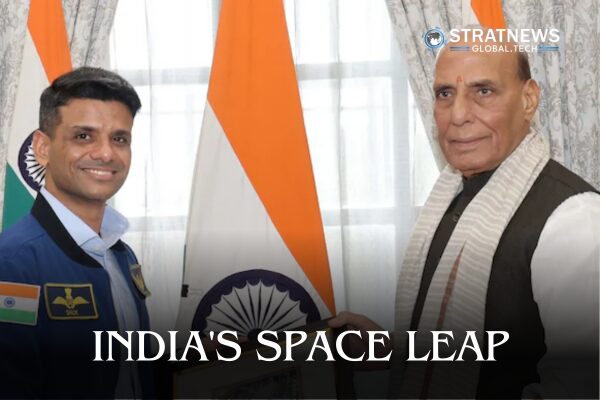In a moment symbolizing India’s growing ambitions in space, Defence Minister Rajnath Singh met Group Captain Shubhanshu Shukla, the first Indian astronaut to live and work aboard the International Space Station (ISS), in New Delhi on Thursday. The high-profile meeting celebrated a pivotal milestone in India’s human spaceflight journey and marked the formal recognition of Shukla’s achievement at the national level.
Calling it a “defining moment for India’s scientific aspirations,” Singh praised Shukla’s pioneering 18-day mission as a source of inspiration for India’s youth, especially those pursuing careers in science, technology, and aerospace. “His journey will motivate young minds to look towards the sky, not just as a limit, but as a destination,” Singh said in a post on X following their interaction.
A Meeting Beyond Ceremony
The meeting was more than a ceremonial handshake; it reflected a national convergence of science, defence, and diplomacy. Singh acknowledged the strategic role of the Indian Air Force (IAF) in India’s space roadmap, from astronaut selection and rigorous training to operational support in missions such as Gaganyaan, India’s upcoming indigenous human spaceflight project.
Singh underlined the IAF’s professionalism as a cornerstone in enabling India’s leap into manned space missions, describing Shukla’s success as proof of this synergy between defence forces and ISRO. “India’s space rise isn’t a solo journey, it’s a team effort, with our armed forces playing a crucial role,” he said.
A Mission That Made History
Launched on June 27 aboard Axiom Mission 4 (Ax-4), a private international flight organized by Axiom Space in collaboration with SpaceX, Shukla became the first Indian astronaut to visit the ISS since Rakesh Sharma’s 1984 mission. He joined a multinational crew comprising NASA astronaut Peggy Whitson and European astronauts Slawosz Uznanski-Wisniewski and Tibor Kapu.
During his time in orbit, Shukla conducted seven microgravity experiments developed by Indian researchers, covering biological, agricultural, and biotechnological fields. These included studies on human muscle cell growth, tardigrades, methi and moong seed sprouting, cyanobacteria, and microalgae, laying critical groundwork for future life-support systems in space.
The mission concluded with a successful splashdown off the California coast on August 19, marking India’s re-entry into human space exploration after more than four decades.
Scientific, Strategic, and Symbolic Impact
The mission has received accolades from across India’s space and defence ecosystem. Industry leaders hailed it as a precursor to Gaganyaan and a demonstration of public–private collaboration involving ISRO, Skyroot Aerospace, and other Indian startups.
Gaganyaan and Beyond
With ISRO’s Gaganyaan mission on the horizon and growing global partnerships, India is positioning itself not just as a cost-effective launch provider, but as a frontline nation in human spaceflight.


